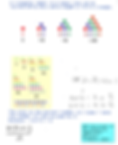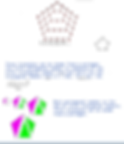Properties of numbers have been of much interest to Mathematicians from the days of the ancient Greeks. My article on Number systems talks about the history of numbers. Another article on Natural numbers explains the main types of natural numbers (being the basic set in the classification of numbers). We learnt about even and odd numbers which are also called consecutive numbers (numbers that follow continuously in order). They are mainly the regular counting order.
This article will reveal to us more of the other special numbers used in Maths. They are special because they form a series of patterns that follow a formula and proving the patterns to be always true. Most of them can be arranged into regular shapes such as triangles and squares. They are mostly grouped under figurate numbers. The first figurate number is always 1.
There are some positive numbers (integers) that are the sum of their positive divisors (excluding themselves). These are called Perfect Numbers. A perfect number is equal to the sum of all the numbers divisible by it ( also called factors) apart from the number itself. For instance 6 has 1, 2, 3 and 6 as its divisors (factors). Meanwhile, adding the factors 1, 2 and 3 without 6 itself give a total of 6. This makes 6 a perfect number.

A perfect number can also be defined as a number that is half the sum of all its positive divisors including itself. For example 28 has 1, 2, 4, 7, 14 and 28 (itself) as factors including. Adding up all its factors including itself gives 56, and half of this sum is equal to the original number 28 ( making 28 a perfect number). The first four perfect numbers are 6, 28, 496 and 8,128. There are 48 perfect numbers discovered so far. However, it is believed that there could be an infinite number of perfect numbers since prime numbers are infinite as well.
The figurate numbers can be shown by taking points or dots and arranging them into regular shapes such as triangles and pentagons. An example is 3; You can take 3 points and arrange them to form a triangle. Figurate numbers can build up into a series of patterns. They can be ordered to show how they grow and thus form a sequence. The type of figurate numbers include a triangular, rectangular, square, pentagonal and hexagonal numbers. These numbers also fall into the category of polygonal numbers.

Cube numbers are a type of figurate numbers that represent 3D shapes in the form of cubes. Their cubes are of equal lengths, widths and heights. A whole number is multiplied by itself twice to get a cubic number (Their third powers). The first 10 positive cubic numbers are 1, 8, 27, 64, 125, 216, 343, 512, 729 and 1000. These are the cubes for the numbers 1 through 10. There are some square numbers that are also cube numbers. They are 0,1,64, 729 (perfect 6th powers).
A triangular number is a number that can be represented by dots and arranged to form a triangle. For eg. 1 starts the numbers and that forms the first dot of a triangle. To build the next triangle we join the first dot with two dots to form the first triangle with three points (3 vertices). We can draw the next bigger triangle by following three more dots and adding up to make 6 (points) as the next triangular number. The subsequent one is formed by adding 4 more dots, making a total of 10 as the triangular number after 6. The next is 15 which has 5 more dots. The rule is the pattern number (n) times 1 more than the number (n) and divided by 2. Formula : n(n+1) / 2
Half the product of two consecutive numbers will give us a triangular number.


From triangular numbers we can have a new pattern of numbers. By adding the triangular numbers 1 and 3 dots we get 4. When we add 6, the next triangular number, we get 9. 6 plus the one after is 16. The numbers 4, 9 and 16 are perfect squares numbers. Visually merging one triangle to the one next to it makes up a square number. Square numbers make up the same number of rows as their columns. So 16 is a square number because it has
4 sets of rows by 4 sets of columns.
4 x 4= 16
My article on Square numbers explains squares in more detail.
Some numbers can also form the shape of rectangles when their dots are arranged. These are called Rectangular numbers. Examples include 1, 4, 6, 8 and 9. All square numbers except 1 are also rectangles. Their points or dots are also arranged in columns and rows to give the rectangular shape.
So the number of columns by the number of rows will make a rectangular number. This implies that the product of any two numbers will make a rectangular number. For example 5 columns by 2 rows of dots make 10 dots. Composite numbers are therefore rectangular numbers while Prime numbers are not.
Triangular numbers are also related to rectangular numbers: Every triangular number is half of a rectangular number.

Another type of figurate numbers are Pentagonal numbers. These numbers extend the concepts of triangular and square numbers to the pentagon (five sided polygon). They show a pentagonal pattern of dots. 1 is the first number and from there we have four more dots (points) to join and make the 5 sided polygon. From the same vertex, they can be generated into a larger pentagon with seven dots. The first five pentagonal numbers are 1, 5, 12, 22, and 35. Each pentagonal number is the sum of three triangular numbers. Three triangles can be drawn from a pentagon. The fifth pentagonal number is composed of the fifth triangular number (15) and twice the 4th triangular number (10 x 2 = 20). 15 + 20 = 35.
The 10th triangular number is
(10 x [ 10 + 1] /2 = 55) and twice the 9th is ([9 x 10] / 2) x 2 = 90.
To get the 10th pentagonal number 55 + 90 = 145

The figurate numbers that represent the shape of a regular hexagon (6-sided polygon) are called hexagonal numbers. The nth (position) hexagonal number is the number of points in a hexagon with a regularly spaced points on one side. Below is a visual representation of the first 5 hexagonal numbers. 1, 6, 15 28 and 45.
All hexagonal numbers are also triangular numbers but only every other triangular number is a hexagonal. Even perfect numbers are also hexagonal numbers. They also follow a pattern rule. N = 2n-1 .
When the hexagons are overlaid, they share one vertex (the point where two or more lines meet).

We have discussed, in this article, some special numbers in the number system that can be arranged to form regular shapes.
There are:
1. Perfect numbers that are the sum of all its factors apart from the number itself;
2. Cube numbers formed when numbers multiplies themselves twice;
3. Triangular numbers which are half the product of two consecutive numbers;
4. Square numbers that have the same number of rows as columns multiplying;
5. Rectangular numbers being the product of two numbers;
6. Pentagonal numbers which make up the sum of the sum of three triangular numbers; and
7. Hexagonal numbers that are built up with a regularly spaced points on from all its sides but with a single vertex just like the pentagon.
To conclude, figurative numbers form the main source of number sequences. The next article will be on the types of Number sequences.












